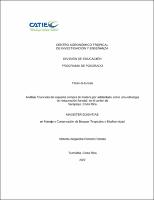Mostrar el registro sencillo del ítem
Análisis financiero del esquema compra de madera por adelantado, como una estrategia de restauración forestal, en el cantón deSarapiquí, Costa Rica
| dc.contributor.advisor | Imbach Hermida, Alejandro C | |
| dc.contributor.author | Romero Romero, Victoria Alejandra | |
| dc.date.accessioned | 2022-10-12T20:30:02Z | |
| dc.date.available | 2022-10-12T20:30:02Z | |
| dc.date.issued | 2022 | |
| dc.identifier.uri | https://repositorio.catie.ac.cr/handle/11554/12068 | |
| dc.description | Tesis (Mag. Sc.) -- CATIE, 2022 | es_ES |
| dc.description.abstract | En el presente estudio se analizó financieramente la ejecución de la compra de madera por adelantado como una estrategia de restauración promovida e impulsada por FUNDECOR en los años noventa,en el cantón de Sarapiquí Costa Rica. La metodología empleada se basó en un análisis costo/beneficio ex post para estimar la rentabilidad financiera en el supuesto de cuatro escenarios en cada una de las fincas. Para este estudio exploratorio, en donde,se trabajó con cinco fincas que ejecutaron la estrategia, el primer escenario en donde se incluye la Mano de Obra Familiar (MOF) como costo resultó ser rentable para una finca, el segundo escenario en donde se sigue incluyendo la MOF, pero se excluyen como costos el monitoreo y supervisión consideradas actividades en donde los propietarios participaron activamente, resultó ser rentable para dos fincas, el tercer escenario en el que no se toma en cuenta la MOF es rentable para dos fincas y por último, el cuarto escenario en donde no se incluye la MOF ni la compra de las plantas resulta ser rentable en 4 fincas. Además, se identificaron 25 servicios ecosistémicos resultantes de la puesta en marcha de la estrategia de los cuales se priorizaron servicios ecosistémicos como “Muy importante” el agua para consumo, “Importante” la belleza del paisaje y recreación y “Poco importante” la purificación del aire. | es_ES |
| dc.description.abstract | In this study a financial analysis of the implementation of a afforestation process based on the purchase in advance of wood several years before the wood harvesting time. This process was promoted by FUNDECOR in the nineties as a restoration strategy, in the canton of Sarapiquí, Costa Rica. The methodology used was an ex post cost/benefit analysis to estimate the financial results of four hypothetical scenarios in each of the farms. For this exploratory study where we worked with five farms that executed the strategy, the results indicate the first scenario where the Family Labor (MOF) cost is included turned out to be profitable for one farm, scenario two where the MOF continues to be included but excludes monitoring and supervision as an activity in which the owners actively participated, it turned out to be profitable for two farms. The third scenario in which the MOF is not taken into account is profitable for two farms and finally the fourth scenario that does not include the MOF nor the purchase of the plants turns out to be profitable in 4 farms. In addition, 25 Ecosystem Services were identified as a result of the implementation of the strategy, of which ecosystem services were prioritized as "Very important" water for consumption, "Important" the beauty of the landscape and recreation and "Little important" the purification of the air. | es_ES |
| dc.format.extent | 39 páginas | es_ES |
| dc.language.iso | es | es_ES |
| dc.publisher | Centro Agronómico Tropical de Investigación y Enseñanza (CATIE) | es_ES |
| dc.relation.ispartof | Magister Scientiae en Manejo y Conservación de Bosques Tropicales y Biodiversidad | |
| dc.subject | ANALISIS ECONOMICO | |
| dc.subject | ANALISIS DE COSTOS Y BENEFICIOS | |
| dc.subject | RENTABILIDAD | |
| dc.subject | SERVICIOS DE LOS ECOSISTEMAS | |
| dc.subject | PLANTACION FORESTAL | |
| dc.subject | REHABILITACION FORESTAL | |
| dc.subject | RESTAURACION | |
| dc.subject | COSTA RICA | |
| dc.subject | SARAPIQUÍ -- COSTA RICA | |
| dc.subject.other | Sede Central | es_ES |
| dc.title | Análisis financiero del esquema compra de madera por adelantado, como una estrategia de restauración forestal, en el cantón deSarapiquí, Costa Rica | es_ES |
| dc.type | Tesis | es_ES |
| dc.identifier.status | openAccess | es_ES |
Ficheros en el ítem
Este ítem aparece en la(s) siguiente(s) colección(ones)
-
Tesis [3111]


